11 Best Online Community Platforms for 2024 | Compared
B2B customers join online communities to seek product insights, network with others, and access knowledge from trusted peers. At its core, a brand’s online community is a space to engage with customers by helping them achieve their goals. B2B customers who are fully engaged have a 23% higher lifetime value. To make the most of […]
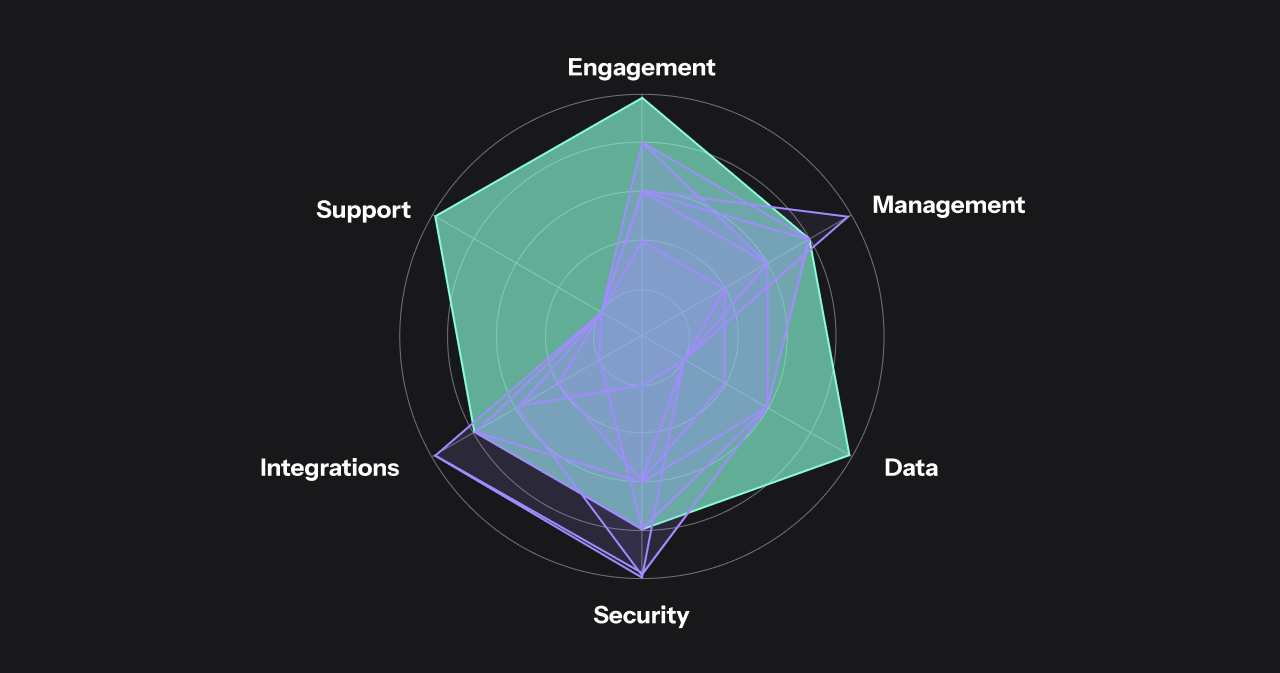
B2B customers join online communities to seek product insights, network with others, and access knowledge from trusted peers. At its core, a brand’s online community is a space to engage with customers by helping them achieve their goals. B2B customers who are fully engaged have a 23% higher lifetime value. To make the most of this opportunity, as the community leader, choosing the best online learning community platform for your business is an important decision.
A guide to the best online community platforms
Online community platforms are key for enhancing customer engagement, knowledge sharing, and connections in businesses. As each team’s needs vary, it’s important to select the right online community platform that aligns with your specific business goals and customer base.
We’ll cover the essentials of online community platforms, including their purpose, setup, benefits, and features. Additionally, we’ll highlight 11 top platforms.
Lastly, we’ll guide you in choosing the right platform for your organization, with a focus on customer engagement and effective knowledge sharing. Navigate to the right section based on where you are in your online community platform selection process:
-
What is an online community platform?
-
How do you implement an online community platform?
-
Advantages of using an online community platform
-
Essential features of a successful online community platform
-
Top 11 online community platforms
-
How to pick the best online community platform for you
-
5 common questions about online community platforms
-
Begin your community strategy to select the ideal platform
What is an online community platform?
An online community platform is a digital space where individuals with similar interests can connect, share knowledge, and engage with each other. Dedicated community platforms are ideal for businesses looking to create stronger customer connection by helping engage customers through centralized discussions, resource sharing, and events. They are valuable for businesses to directly interact with customers, gather feedback, and strengthen brand loyalty. Essentially, these platforms are not just for conversations but are ecosystems that encourage participation to enhance customer learning and growth.
Most online community platforms work by giving members the ability to create a profile, join discussions, share various types of content like articles and videos, and communicate through private messages. Administrators or moderators ensure conversations stay respectful. Users get notifications about new posts and activities to keep them engaged. Additionally, these platforms often list and host online events for more interactive, real-time experiences.
How do you implement an online community platform?
To select the ideal online community platform based on your business goals and member needs, it’s important to have a clear plan of action. Here are the steps we recommend to go from cold start to full launch:
Strategy Development
Determine your community’s role in the customer lifecycle, establish its purpose, decide its size, create member personas, and map out member engagement pathways.
Gaining Backing
Forecast your community’s ROI and present the strategic plan to key stakeholders.
Platform Selection
Initiate procurement and budgeting, define platform requirements, and finalize pricing and terms.
Planning Phase
Kick off the community project with key stakeholders and conduct platform training.
Building the Community
Establish the community’s structure, guidelines, and content strategy, migrate if needed, and set up engagement plans, early access profiles, integrations, and community analytics.
Soft Launch
Launch a welcome campaign for the soft launch phase, and collect feedback while monitoring performance.
Full Launch
Develop a full launch campaign, plan for ongoing management, and promote the community through existing channels. If you’d like a more in-depth, step-by-step breakdown of how to launch an online community platform, you can access our full guides by joining the Zapnito Community.
Advantages of using an online community platform
Online community platforms provide a range of advantages for businesses, enhancing customer engagement and fostering brand loyalty. Here’s a more comprehensive summary incorporating the additional points:
Increased customer lifetime value
By enhancing post-sales success, streamlining access to information, a successful community experience increases the chances of customers spending more and decreases the chances of them leaving for alternative providers.
Enhanced customer engagement and loyalty
Creating a dynamic space for customer interaction, fosters loyalty and a sense of community, while reducing support and marketing costs through efficient self-service and user-generated content.
Cost efficiency
By streamlining customer support and marketing operations in one place, online community platforms effectively cut costs, including lowering acquisition costs through user-generated content that attracts new customers.
Revenue growth and innovation
Promoting product awareness, enabling peer recommendations for direct sales, and leveraging customer feedback drives continuous improvement and advocacy.
Overall, online community platforms provide a streamlined approach to improving customer experience, fostering brand loyalty, and streamlining business operations. If you’d like to explore the opportunity and methodology behind community-led growth in more detail, you can access hundreds of valuable resources as a member of Zapnito Community.
Community-Led Growth: From Social Media to Branded Community Website
Essential features of a successful online community platform
There are a number of different community solutions available. The most effective community platforms are built for specific use cases. Considering these essential features will help you identify the best solution for your business:
Knowledge sharing and engagement
Above all else, an online community platform must provide a user experience which is easy to use and encourages participation. One of the key distinctions between a static knowledge base and a community platform is the ability for members to engage with each other. Member profiles and group directories are important ways for members to find and connect with relevant people, while discussion forums and private messaging provide vital public and private spaces for exchanging ideas and solving problems.
Beyond member connection, an online community platform should make it easy to find the right knowledge at the right time. This could be content created by your brand or published by members. With articles, video, documents and courses all available in one place, the community platform is more likely to become an essential contributor to customer’s long-term success and loyalty. If your community consists of different groups, for example customers at different lifecycle stages, it’s important your community platform can provide a personalized knowledge sharing experience for each member.
Customization and management
Although user experience is paramount with an online community platform, it has to be easy for your team to create and manage this ideal experience. A big difference between many online community platforms is the level of control you, the community manager, has over how the platform looks and is structured. For larger communities, it is essential that member groups can be easily segmented and assigned specific permission e.g. access a specific course or post an article. A multi-community architecture may be needed for managing several sub-communities in one place, or public/private rooms can ensure members only engage with the right content, people and activities.
Once you’ve built your ideal community structure, ideally with custom branding and on a custom domain, your community platform should also remove manual work from creating stickiness through personalized community notifications, newsletters and @mentions.
Data and analytics
When you’re inviting valuable customers, prospects or partners to participate in your community, it’s important to get a clear view of who is most and least engaged. Without ownership of member behavior data, it makes it difficult to identify which members to contact 1-on-1 to encourage them to become advocates or proactively stop them from churning as a customer. The greater the control your community platform gives you over community data through reports and dashboards, the more your business can uncover valuable insights into organizations, members, and activity types.
Security and privacy
Prioritizing security and privacy is crucial. Data breaches can quickly ruin all the valuable trust built. Essential measures include enforcing strong password strength policies and securing data with SSL Certificates to protect information during transit. Platforms should also maintain audit logs for monitoring activities, and implement Single Sign-On (SSO) systems for secure, streamlined access. Making sure your community platform vendor prioritizes these rigorous security protocols gives both your business and member peace of mind, creating an environment for safe and trustworthy online engagement.
Integrations
Connecting your existing tech stack to your community creates limitless opportunities for enhanced customer engagement and support. Unless the platform has the option for direct or custom integrations, tools like Zapier automate workflows by linking the platform with various apps, streamlining operations. Being able to connect Google Analytics and Tag Manager offer also allow you to sync valuable insights into user behavior, aiding in data-driven decision-making to optimize performance on different channels. Some community platforms also offer a feed directly into your data warehouse, allowing your business to aggregate extensive user data, providing a holistic view of community interactions. These integrations together facilitate a seamless flow of information across business segments, enriching the overall customer experience through deeper personalization.
Implementation and strategic support
Choosing a platform is one thing, but getting the right foundations in place and delivering long term value is also crucial. Different online community platforms offer very different levels of implementation and strategic support, particularly those that are aimed at smaller businesses and individual entrepreneurs. Given that today, teams often face the challenge of driving more results with less budget essential services such as a dedicated community success team and one-on-one platform training provide tailored support that can be make or break for a platform’s effectiveness.
Beyond getting set up and taking control of how your platform is structured, a launch roadmap and ongoing business reviews ensure that the platform continually aligns with the evolving needs and goals of the community. If you’re upgrading your community platform, migration support is also invaluable for a smooth transition from other platforms, maintaining data integrity and minimizing disruption. Ultimately your community platform vendor should become a partner who cares just as much as you about the long term success of your community.
Top 11 online community platforms
When looking for an online community platform there’s no shortage of choice. To help you come to a decision faster, we’ve listed the 10 best platforms on the market. Here they are.
Zapnito – Best for B2B brands
Zapnito provides B2B businesses with a one-stop destination for customers to connect with their peers and share knowledge – with discussions, content, courses, events and more – under one brand domain. To ensure your community’s long-term success – engagement dashboards help drive ROI, and our team of experts provide essential strategic guidance. Zapnito provides one of the most expansive feature sets for members to share knowledge in different formats e.g. articles, video, discussions and courses. Also the platform can be fully customized to match your brand guidelines.
5 highlight features
- White label design
- Member/Organisation profiles
- Premium content – courses, articles, video, documents
- Discussions
- Community analytics
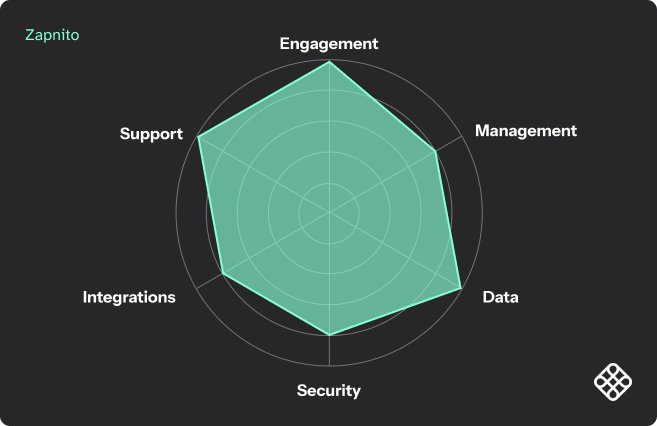
Strengths and weaknesses
- Engagement features: 5/5
- Management features: 4/5
- Data features: 5/5
- Security features: 4/5
- Integration features: 4/5
- Support services: 5/5
- Customer reviews: 4.7/5
Discord – Best for interest-based chat rooms

Discord is a communication platform designed to bring people together, whether it’s for school clubs, gaming groups, or global communities. It offers a space where users can chat, voice call, and video call, making it easy for friends and communities to hang out virtually. Like Slack, Discord is a quick and cheap way to create a community proof of concept but can quickly get messy at scale and has limited ways for members to share knowledge outside long chat threads.
5 highlight features
- Voice Channels
- Text Channels
- Live Streaming
- Customizable Servers
- Member Profiles
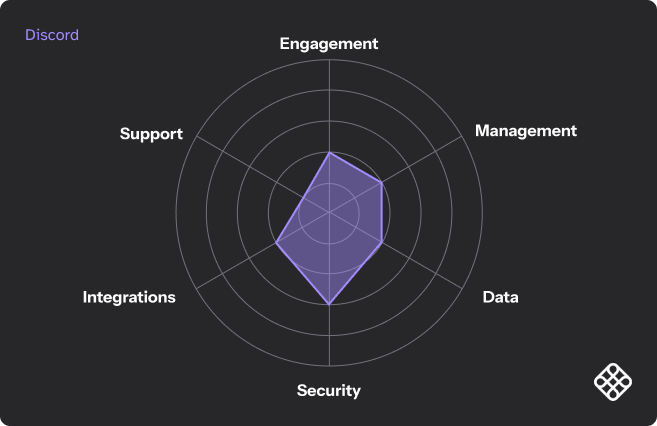
Strengths and weaknesses
- Engagement features: 2/5
- Management features: 2/5
- Data features: 2/5
- Security features: 3/5
- Integration features: 2/5
- Support services: 1/5
- Customer reviews: 4.7/5
Mighty Networks – Best for solo entrepreneurs and creators

Mighty Networks is a platform designed for creators, entrepreneurs, and brands to build and grow their own communities, courses, and memberships. It emphasizes the power of placing community at the center of online offerings, resulting in enhanced member experiences. Mighty Networks places a strong focus on helping entrepreneurs monetize access to courses and providing templated mobile apps.
5 highlight features
- Activity feed
- Spaces
- Live stream
- Member Profiles
- Courses
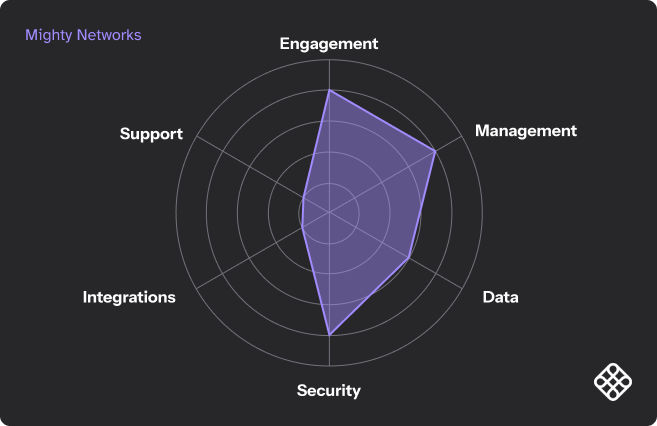
Strengths and weaknesses
- Engagement features: 4/5
- Management features: 4/5
- Data features: 3/5
- Security features: 4/5
- Integration features: 1/5
- Support services: 1/5
- Customer reviews: 4.3/5
Discourse – Best for forum-only support

Discourse is an open-source internet forum system which many big brands have utilized to deliver well organized community-led support. As probably the most customizable community platform on the market, it can be complex and overwhelming for both community managers and end users.
5 highlight features
- Conversation forums
- Live chat
- AI moderation
- Admin dashboard
- Comprehensive API
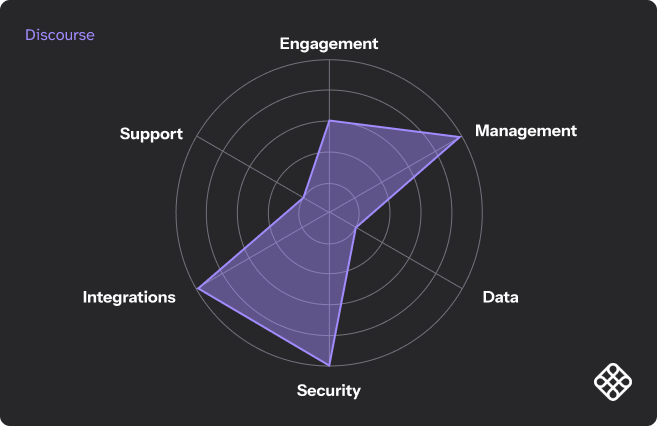
Strengths and weaknesses
- Engagement features: 3/5
- Management features: 5/5
- Data features: 1/5
- Security features: 5/5
- Integration features: 5/5
- Support services: 1/5
- Customer reviews: 4.6/5
Slack

Slack is a versatile communication platform mostly used for internal team discussions but also leveraged to create community discussion threads. Through Slack’s organized channels, companies can foster a sense of community, allowing customers to chat, share links, and engage in real-time discussions. Slack is often used as a tool to create a community proof of concept but can quickly get expensive at scale.
5 highlight features
- Channels
- Messaging
- Huddles
- Clips
- Canvas
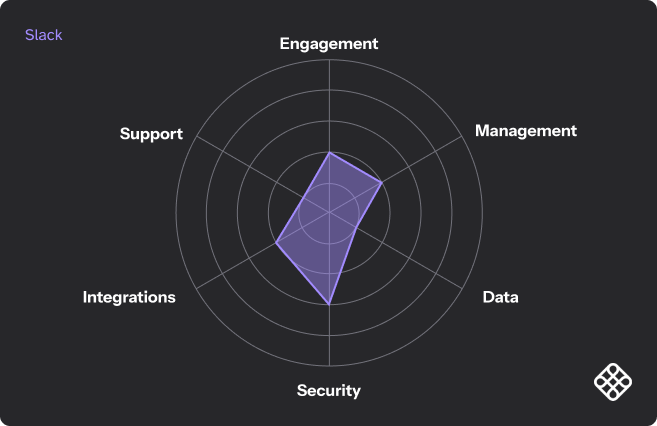
Strengths and weaknesses
- Engagement features: 2/5
- Management features: 2/5
- Data features: 1/5
- Security features: 1/5
- Integration features: 2/5
- Support services: 1/5
- Customer reviews: 4.6/5
Bettermode

Formerly known as Tribe, Bettermode is a customer-focused community platform aimed at increasing user engagement and reducing support tickets by centralizing product information. Its heavily templated approach and focus on an activity feed makes it easy to get set up quickly but has many limitations at scale.
5 highlight features
- Spaces
- Member profiles
- Activity feed
- Community analytics
- Templates
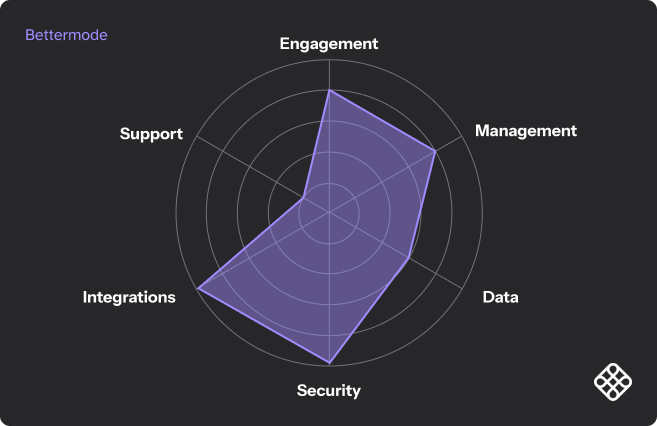
Strengths and weaknesses
- Engagement features: 4/5
- Management features: 4/5
- Data features: 3/5
- Security features: 5/5
- Integration features: 5/5
- Support services: 1/5
- Customer reviews: 4.7/5
Hivebrite

Hivebrite is an online community platform built mainly for membership organizations and associations that focus on member networking. It is customizable to provide a space with a distinctive visual identity and structure which can be hard to navigate, particularly for larger communities.
5 highlight features
- Member profiles
- Content editor
- Event directory
- Map & Directory
- Activity feed
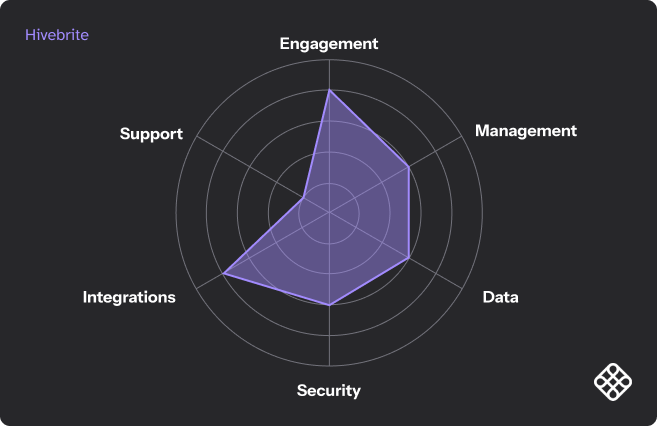
Strengths and weaknesses
- Engagement features: 4/5
- Management features: 3/5
- Data features: 3/5
- Security features: 3/5
- Integration features: 4/5
- Support services: 1/5
- Customer reviews: 4.4/5
Circle

Circle.so is a highly templated platform designed for entrepreneurs and creators to share and monetize courses and events. It has a lot of engagement features for a lower cost platform but its limited customization and analytics means larger businesses will quickly struggle at scale to integrate the experience into their wider brand ecosystem.
5 highlight features
- Discussions
- Spaces
- Live streams
- Courses
- Private messaging
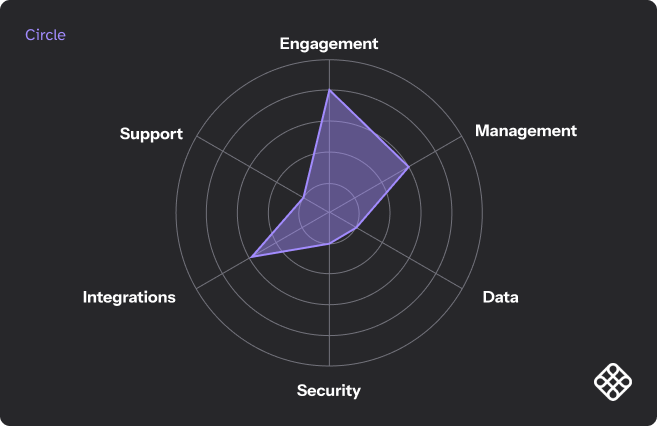
Strengths and weaknesses
- Engagement features: 4/5
- Management features: 3/5
- Data features: 1/5
- Security features: 1/5
- Integration features: 3/5
- Support services: 1/5
- Customer reviews: 4.3
Salesforce Experience Cloud

Salesforce Experience Cloud is a customizable platform available as part of a suite of engagement products. It can be used to build interactive sites, apps, and portals, which can be a strength for existing salesforce customers, but a costly and time consuming solution for brands that need a specific solution for community management.
5 highlight features
- Dashboards and Reports
- Customizable themes
- Groups
- Topics
- E-Commerce
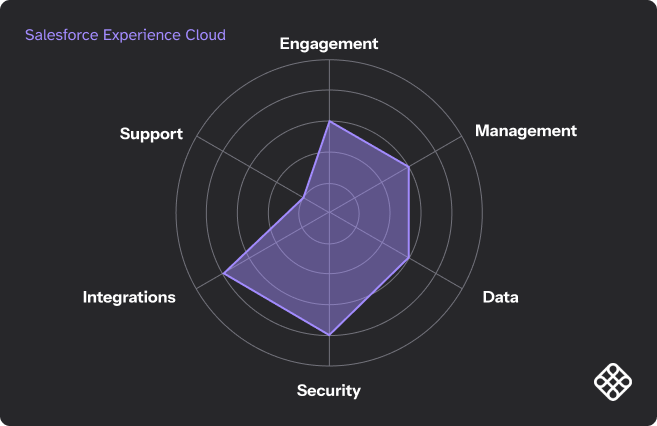
Strengths and weaknesses
- Engagement features: 3/5
- Management features: 3/5
- Data features: 3/5
- Security features: 4/5
- Integration features: 4/5
- Support services: 1/5
- Customer reviews: 4.3/5
Khoros Communities

Khoros Communities is an online platform built around customer support forums with a focus on giving members badges for answering community questions. As part of a wider suite of customer engagement products, many big brands have used Khoros as a legacy platform to run community-led support but are limited in how they create more valuable knowledge sharing experiences at scale.
5 highlight features
- Gamification
- Forums
- Event listings
- Blogs
- Moderation tools
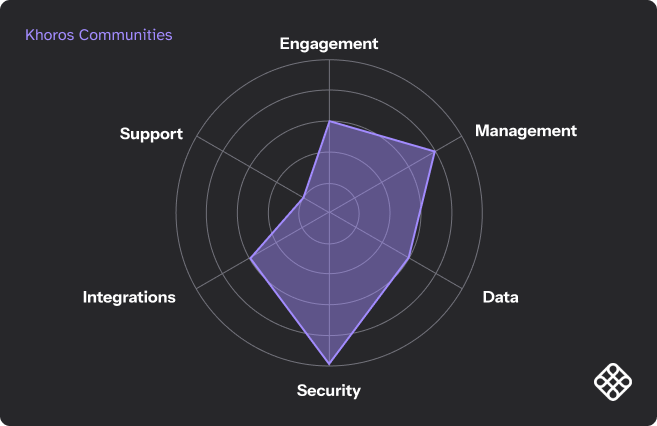
Strengths and weaknesses
- Engagement features: 3/5
- Management features: 4/5
- Data features: 3/5
- Security features: 5/5
- Integration features: 3/5
- Support services: 1/5
- Customer reviews: 4.3
Gainsight Digital Hub

Gainsight Digital Hub, previously Insided, specializes in customer support forums and features leaderboards highlighting members who actively respond to support queries. This platform integrates well with other Gainsight customer engagement tools, but for not already using Gainsight’s suite, implementing Gainsight Digital Hub as a standalone community solution could be an expensive option.
5 highlight features
- Forums
- Community dashboards
- Branding customization
- Gamification
- Event listings
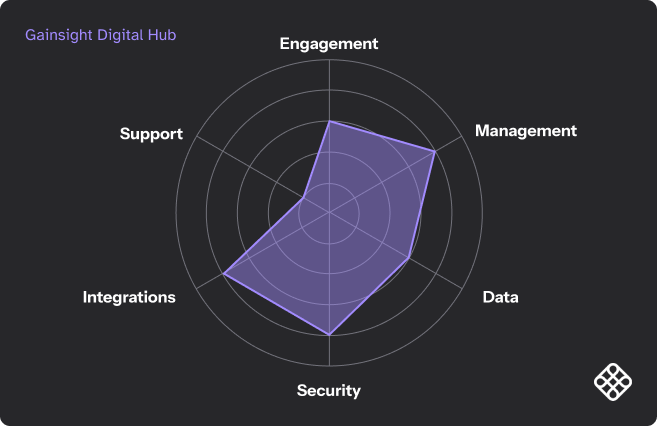
Strengths and weaknesses
- Engagement features: 3/5
- Management features: 4/5
- Data features: 3/5
- Security features: 4/5
- Integration features: 4/5
- Support services: 1/5
- Customer reviews: 4.4
Conclusion

As you can see by the graph comparing different online community solutions, Zapnito (highlighted in red) is the best all-rounder. Some online communities may not need this level of enterprise-grade functionality and support, but for B2B brands, this comprehensive offering provides everything needed drive long-term impact.
How to pick the best online community platform for you
Choosing the ideal community platform for your business should begin with a clear, strategic foundation. A well-defined community strategy should focus on optimizing specific stages in the customer lifecycle, catering to the unique needs of different member groups, whether they’re prospects, new customers, or established clients.
Platform providers that cater for enterprise level businesses should offer expert strategic advice before you buy to make sure you leverage what works for similar businesses. With a strategy in place, you can ensure that your community platform choice aligns seamlessly with your business objectives, making it an integral part of the long-term growth of your business.
Choosing the right community platform should be approached in three short phases:
1: Procurement
If you are leading your company’s community strategy and the key decision maker in which platform to choose, it’s important you involve other key stakeholders early on. Partnering with your colleagues in charge of technology procurement will ensure the right processes are followed and you can clearly communicate the technical needs of your strategy to vendors.
Defining roles and responsibilities, possibly through a RACI chart, is vital for effective collaboration across departments like Product Development, Marketing, and the Web Team. The more you bring other departments on board to buy into the benefits of community, the greater your forecasted ROI, and the more budget you will gain to invest in your community’s long-term success.
2: Requirements
The second phase is selecting platform requirements, which should align with your community strategy. If you have mapped out ideal community member pathways as part of your strategy, you will have a much clearer idea of the experience you need a platform to deliver. In addition to the end user experience, it is also important to consider what functionality your team will need from a backend perspective. The best platform vendors will be able to respond to your own custom list of requirements or provide you with RFI (request for information) templates beyond demo calls.
3: Pricing and terms
Once you’ve researched, shortlisted, and spoken to a number of potential vendors, one of the most critical decisions is to assess their commitment to supporting your community’s growth. In addition to the level of implementation and customization support the vendor will help you achieve, assessing cultural fit and communication style with the vendor is also important for a successful partnership. This comprehensive approach ensures the platform chosen not only meets immediate needs but is also sustainable and adaptable for future growth.
Following these three phases will ensure your whole organization gets fully behind your community platform selection, giving you the best chance of getting quickly set up and delivering value.
5 common questions about online community platforms
Whether your business is looking to deepen customer relationships or enhance collaboration, understanding what is involved in building a successful community is crucial. These questions are commonly asked by community project leads when assessing platform options.
Why would I need a community platform when I could create a Facebook/LinkedIn/WhatsApp group?
Creating a ‘community’ space on a social media platform takes minimal effort but is only really viable for engaging very small groups. These platforms are designed to keep users continually distracted, meaning your members will rarely focus and share knowledge of value. Data also is owned by the social media company which considerably limits your ability to leverage your community to deliver a more integrated brand experience.
Do I need a mobile app version of my community platform?
The demographics and daily habits of your community members will dictate how and when they will engage with your platform. A mobile responsive experience is critical to ensuring members can participate on any device. A fully mobile-responsive provides a seamless user experience on mobile devices without the drawbacks of app downloads or frequent updates. The best vendors will also provide adaptable backend technology that allows you to integrate community features into custom-built apps if essential.
How much time should my company dedicate to managing my community?
Community management can take on different forms depending on the objectives, purpose and size of your community. To drive engagement and participation from members, it’s vital that your brand contributes content and opportunities for members to engage with each other. Moderation and community operations should also have ownership to create the best possible experience for members. We recommend a minimum of 10 hours per week is dedicated to driving engagement, at least for the first months of your community launch. Team members with existing relationships with your ideal community members are best placed to create high value and frequency engagement.
How can I move all the existing content and engagement from my existing platform to a new one?
The best enterprise level community platforms will have processes in place to manage the migration from one platform to another. This technical support can remove the responsibility from your own team and also minimize friction for members. It is worth asking any potential vendors about their processes and costs for migration support as this will increase the price beyond the platform alone.
How can I monetize community membership?
There are a number of different ways that a community platform can generate new revenue streams in addition to enhancing your existing customer experience. Offering a subscription to access the community as a paid membership is the most common as most widely supported by community platforms. This same pay-to-access principle can also apply to specific content in your community e.g. courses, documents or access to 1-on-1 with expert members. Other brands leverage the functionality their community platform provides to drive new revenue sources through sponsorship or advertising spaces. Asking potential vendors for case studies of how their customers have monetized their community will help provide inspiration and best practices.
Begin your community strategy to select the ideal platform
Forward thinking brands recognize community is no longer a nice-to-have. With low value engagement creating a 23% loss in potential revenue – connecting customers to their peers to learn, share and grow can transform customer lifetime value.
If you’re looking to build a community strategy, select a platform and launch in weeks rather than months, our Complete Community Launch Playbook will provide you with a full breakdown of what needs to be done.
If you’d like a personalized walkthrough of the Zapnito platform, book a demo today.
